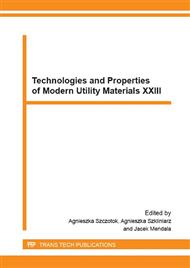p.123
p.127
p.131
p.135
p.139
p.143
p.149
p.153
p.157
The Influence of Substrate Roughness on the Surface Condition of WC-Co Coatings Obtained Using the Supersonic Method
Abstract:
Thermal spraying process is one of the main methods of obtaining the protective coatings. Coating quality largely depends on the proper selection of coating materials, technology and spraying equipment and the method of substrate preparation. The article presents the problem of the effect of surface preparation process on selected properties of the coating produced by supersonic thermal spraying – HVOF. Blast cleaning and supersonic thermal spraying processes were characterized. The influence of blasting parameters on the resulting surface profile and selected properties of the coating, such as roughness, porosity and structure were determined by means of surface profilometry, light microscopy and digital image analysis.
Info:
Periodical:
Pages:
139-142
Citation:
Online since:
February 2016
Authors:
Keywords:
Price:
Сopyright:
© 2016 Trans Tech Publications Ltd. All Rights Reserved
Share:
Citation:


